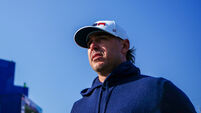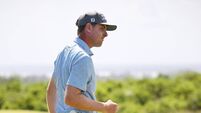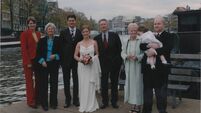The significance of Sawgrass
GEOLOGISTS might quibble over the use of the term swamp to describe the 415 acres of Florida scrub that former PGA Tour commissioner Deane Beman bought in 1978 for a dollar.
The property, a few miles south of Jacksonville Beach, had the requisite alligators, opossums and water moccasins, but it was a good two feet above sea level and would have dried out between storms if Highway A1A wasn't built, shutting off natural drainage routes. "It was a man-made bog," says Vernon Kelly, who was the PGA Tour's project manager during the golf course's construction.
Four years later, at the 1982 Tournament Players Championship, Beman showed the world what he had achieved. Where there used to be muck, there were fairways. Where there used to be mire, there was an island green girdled in wood pilings. The Tournament Players Club at Sawgrass was now a golf course, but it was still a little bit wild. It had large, unruly dunes that looked as if they had been imported from Ireland, sandy flats that seemed to be awaiting a landscaper and grassed berms that resembled primitive battlements.
J.C. Snead played the course and then said: "They ruined a perfectly good swamp".
Time and tweaking have surpassed Snead's judgment. When the tournament, now known as the Players Championship, tees off this morning, 40,000 spectators a day will turn the stadium course at the TPC at Sawgrass into a carnival. More than 400 corporations will entertain clients in hospitality tents and sky boxes, and millions of viewers in 140 countries will catch the action on television.
Meanwhile, the best golfers in the world will play for a purse of $6.5m-a financial bounty that can be traced directly to Beman and his visionary concept of stadium golf.
But don't think for a minute that the trip from swamp to success was an easy one. There's lots of stuff buried under the tightly mown grass of the stadium course. Course architect Pete Dye pushed around tons of decayed organic matter, piled it as high as 45 feet and covered it with sand and grass, creating large mounds along the fairways that formed a natural 'stadium'. The soggy dumping ground of the stadium course makes a pretty good metaphor for the state of the Tour in the mid-'70s, when Beman took over as Tour commissioner.
Arnold Palmer and Jack Nicklaus enjoyed worldwide popularity and commanded top dollar for commercial endorsements, but the Tour itself was bogged down. The four major championships - the Masters, US Open, British Open and PGA Championship - were controlled by other organisations. Tennis, not golf, was the hot participatory sport. Tour events, which relied on the celebrity appeal of hosts like Bob Hope, Andy Williams and Joe Garagiola, routinely got poorer television ratings than ... bowling! Says Beman, "We were a minor sport with major stars."
To avoid sinking further, the Tour had to create new revenue streams. One of Beman's strategies, controversial at the time, was to replace the celebrity hosts with corporate sponsors who would buy hunks of television ad time. An even riskier gambit had the Tour, a tax-exempt membership organisation, staging tournaments on its own.
In 1974 the Tour launched the Tournament Players Championship, which started at Atlanta Country Club and moved twice before finding a temporary home at windblown Sawgrass CC, near the current TPC site. In later years Beman turned the World Series of Golf, a 36-hole, four-player exhibition in Akron, into a full-field Tour event; took a flier with the Seiko-Tucson Match Play Championship, which lasted only three years; and created the season-ending Tour Championship, a high-dollar shoot-out limited to the top 30 players on the money list. "I was quite certain," he says, "that the Tour had to have its own events to compete for the sports and entertainment dollar."
The notion of a permanent home for at least one of these tournaments was always in the back of Beman's mind. Why not build a rota of USGA-owned, spectator-friendly courses that could host the US Open and serve as laboratories for the Green Section's turf grass research?
The USGA had nodded reflectively, puffed on its pipe and thanked Beman for his interest. Nothing happened.
Beman ventured into real estate, course design, equipment design and professional golf, but stadium golf didn't make much headway until 1974, when he was picked to replace outgoing Tour commissioner Joe Dey.
AT the 1975 Phoenix Open the new commissioner decided to see what the pro game looked like from outside the ropes. "I had to buy a periscope to see!" he says. "No wonder we didn't have huge galleries."
To realise Beman's vision of a course on which spectators could see the action whether they sat or walked, designer Pete Dye channelled the excess water off-site and lowered his fairways and greens to sea level. That, in turn, gave him more soil to pile up on the viewing mounds - most of which were positioned on the right side of the fairways so that the fans wouldn't be looking at the players' backs. Dye also made room for the merchandise tents, concession stands and electronic scoreboards that have become fixtures at modern tournaments.
The stadium aspects were brilliant and worked from Day One. The course, on the other hand, exasperated the touring pros. Ben Crenshaw complained of 'Star Wars golf'. Nicklaus said of the greens: "I've never been very good at stopping a five-iron on the bonnet of a car."
Tour veteran Jay Haas says the course was "at the very least unfair. The green complexes repelled the ball. You got ricochets."
Facing an incipient player revolt, Beman called Dye after the '83 tournament and asked him to tour the course with a 10-member player committee that included Nicklaus, Crenshaw and Hale Irwin. "It was 18 holes of grill and roast," recalls golf architect Bobby Weed, who had been hired by Dye to supervise alterations. "There were a lot of egos, but Pete was gracious and accommodating."
Changes would be made over many years. Dye and Weed softened the contours of the greens. They widened several fairways. They eliminated a hungry pot bunker. They installed marker mounds to give golfers something to aim at from the tees. "The initial design was compromised," Weed says, "but all courses evolve. As long as the original architect is involved, it's fine."
More than fine, if you ask the current crop of Tour professionals. "It's Pete Dye at his best," says defending Players champ Davis Love III. "He made a course that's intimidating and challenging and makes you put a lot of thought into playing it."
You have to be very, very stubborn not to give Deane Beman his due. It may have looked as if he was building a golf course in a swamp, but he was actually leading the Tour to higher ground.
(c) Time Inc 2004, from Sports Illustrated magazine.
















